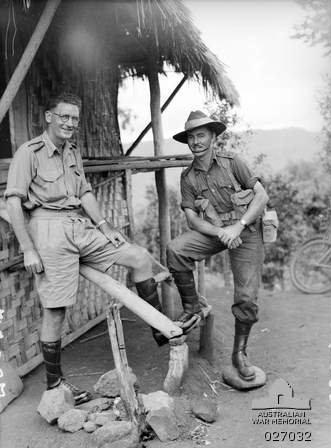 Lieutenant Colonel Allan Gordon Cameron, DSO with Bar
Lieutenant Colonel Allan Gordon Cameron, DSO with Bar
DOB: 16 May 1909
Place of birth: Fitzroy, Melbourne
Allan Cameron was educated at Scotch College, Hawthorne, and joined the Commercial Bank of Australia Ltd. He enlisted in the 46 Bn around 1926 and was commissioned lieutenant on 14 October 1929. Allan resigned from the Militia in 1931, married in 1934 and rejoined the Militia in 1939. On 1 July 1940 he transferred to the AIF as a captain and was posted to the 2/22 Bn. Cameron was the 2/ic of C Company, which was under the command of Captain Appel. C Company was deployed around Vunakanau airfield at the time of the invasion. He made his escape along the north coast of New Britain. “When Keith McCarthy arrived at Pondo (about 20 February) he dispatched Capt Cameron in the launch Dulcy to set up camps west of the Willaumez Peninsula. He failed to do so preferring to make a run for the NG mainland”. Cameron and his group arrived at Salamaua just prior to the Japanese landing there. On the 15 March he was at Kudjera, in the grasslands just east of Wau, and by the 17 March was on his way over the Bulldog Track to the Lakekamu River and Port Moresby.
Cameron was promoted to Major in May and appointed brigade major of the 30th Brigade. After the CO, Bill Owen, was killed 29 July, 39 Bn was reinforced by one company between 31 July and 6 August. Major Allan Cameron, arrived 4 August and took command of Maroubra Force. At this stage it comprised about 43 men of PIB, 464 of 39 Bn, a few from ANGAU and 14 RPC. Cameron decided to retake Kokoda and on 8 August committed A,C and D Companies and recaptured the post. Kokoda was held for 3 days but lack of food and ammunition forced a withdrawal and fall back to Deniki. The enemy again attacked in strength and another withdrawal was affected to defensive positions at Isurava 14 August. Cameron was awarded the Distinguished Service Order.The new CO, Lt Col Ralph Honner assumed command on 16 August.
Cameron then performed liaison duties. He was promoted temporary Lt Col 28 August 1942 and on 2 September was in charge of 53 Bn. A week later he assumed command of 3 Bn, then occupying a defensive position at Ioribaiwa, the furtherest point of the Japanese thrust towards Port Moresby. He led the Battalion in the Australian advance along the Track and in the fighting around Gona in November and December, winning a Bar to his DSO. Cameron was in charge of the composite 3 Bn and 22 Bn in North Queensland from March 1943. On 5 July he assumed command of the 2/2 Bn. Ordered to New Guinea, the unit participated in the nine month Aitape-Wewak campaign which culminated in the surrender of the Japanese Eighteenth Army in August 1945. Cameron was mentioned in dispatches. Lt Col Cameron retired from his command on 14 December 1945 and 2/2 Bn was disbanded February 1946. Between December 1945 and October 1946, he successively commanded the 26 Bn, and 2 NGIB and 3 NGIB ( New Guinea Infantry Battalions) on New Britain until they were disbanded.
Transferring to the Retired List on 25 January 1947, Allan managed a plantation on the island for two years. In 1950 he moved to Victoria and worked a grazing property on the Mornington Peninsula. Next year he took up a 179 ha soldier settlement block on Phillip Island where he ran sheep and cattle. Cameron was prominent in the RSL,was a shire councillor from 1958, a justice of the peace, an elder of the Presbyterian Church and a Freemason. He died of a cerebral haemorrhage on 8 June 1960, aged 51, at Cowes and was buried in the local cemetery. His wife, daughter and three sons survived him.
